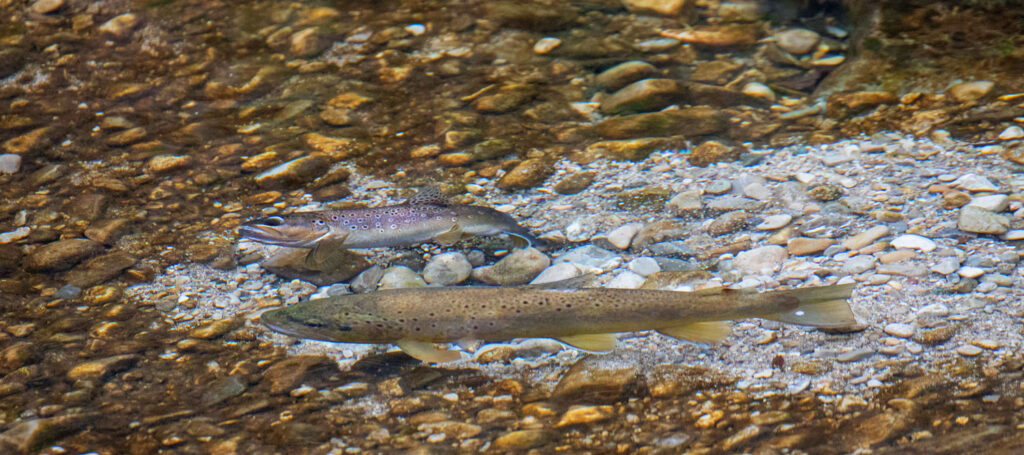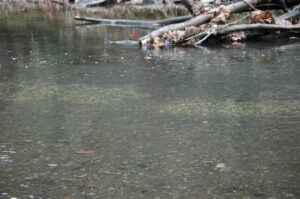It’s fall in Colorado, so let’s learn a little about trout spawning, and more specifically, what redds are and why you should avoid them. By understanding this process, you can help preserve trout populations and ensure the rivers and streams we love stay healthy and productive.
What is a Trout Spawning Season?
Trout, like many fish, have distinct spawning seasons when they reproduce. During these times, they move to specific areas of rivers or streams to lay their eggs, which are then fertilized by male trout. Each species of trout spawns at different times of the year:
- Rainbow Trout: Spawn in the spring, typically between March and May.
- Brown Trout: Spawn in the fall, usually from October to December.
- Brook Trout: Also spawn in the fall, around September to November.
- Cutthroat Trout: Similar to rainbow trout, they spawn in the spring, generally from March to June.
During spawning, trout undergo a lot of physical exertion and stress, making it a sensitive period for their survival and the health of their eggs.

What are Redds?
Redds are the nests that trout create for their eggs. They dig these nests in shallow, gravelly areas of streams or rivers, where oxygen-rich water flows over the eggs to keep them healthy. Redds are crucial for the next generation of trout, and disturbing them can have a huge impact on the future of the fish population.
How to Spot a Redd:
A redd can be identified by its distinct appearance in the riverbed:
- Cleared Gravel: Redds often look like bright, clean patches of gravel that have been swept clean of algae or debris. This is because the trout uses its tail to sweep away sediment and dig a shallow depression in the riverbed.
- Oval or Circular Shape: Redds tend to be oval or circular, typically measuring between one and three feet in diameter.
- Location: Redds are usually found in shallow, fast-flowing water with a gravelly bottom. Trout choose these areas because the flow of water helps oxygenate the eggs.

Why Should You Avoid Redds?
It’s important to give redds a wide berth for several reasons:
- Egg Protection: The eggs laid in these nests are extremely delicate and can be easily crushed or dislodged by foot traffic, wading, or casting. Even the slightest pressure on the gravel can disrupt the eggs and reduce the number of successful hatchlings.
- Future Trout Populations: Damaging redds can significantly affect the future population of trout in that river or stream. Every damaged redd means fewer fish in the future, which affects the entire ecosystem, including future fishing opportunities.
- Unnecessary Stress: Trout are highly protective of their redds. Fishing near them can cause unnecessary stress to the spawning trout, reducing their ability to reproduce successfully.
Tips for Avoiding Redds:
- Know the Spawning Season: Be aware of when trout are spawning in your local rivers. If you’re fishing in the fall, watch out for brown and brook trout redds. In the spring, keep an eye out for rainbow and cutthroat redds.
- Watch Where You Wade: When wading through rivers, be cautious in areas with gravelly bottoms and shallow water. If you spot any bright patches of clean gravel, avoid walking through them.
- Fish in Deeper Water: During the spawning season, it’s best to target deeper pools and slower-moving water away from the redds. The trout you catch will be healthier, less stressed, and more likely to provide a better fight.
- Educate Fellow Anglers: If you see someone accidentally fishing over or disturbing a redd, kindly educate them about the importance of avoiding these areas. Many anglers may not realize the impact they’re having on the fishery.
Ethical Fishing During Spawning Season
While it’s tempting to fish for large trout that are congregating near spawning grounds, it’s important to give them space during this critical time. Some anglers even choose to refrain from fishing in certain rivers during spawning season to allow the fish to reproduce without interruption.
If you do fish during these times, remember:
– Avoid targeting trout that are actively spawning.
– Handle fish gently and release them quickly.
– Be mindful of your impact on the habitat.
Understanding trout spawning seasons and the role of redds is key to becoming a more ethical and responsible angler. By avoiding redds and giving spawning trout the space they need, you’re helping to ensure the health of trout populations for years to come. Let’s all do our part to protect the waters we love!
Tight lines and happy fishing!

